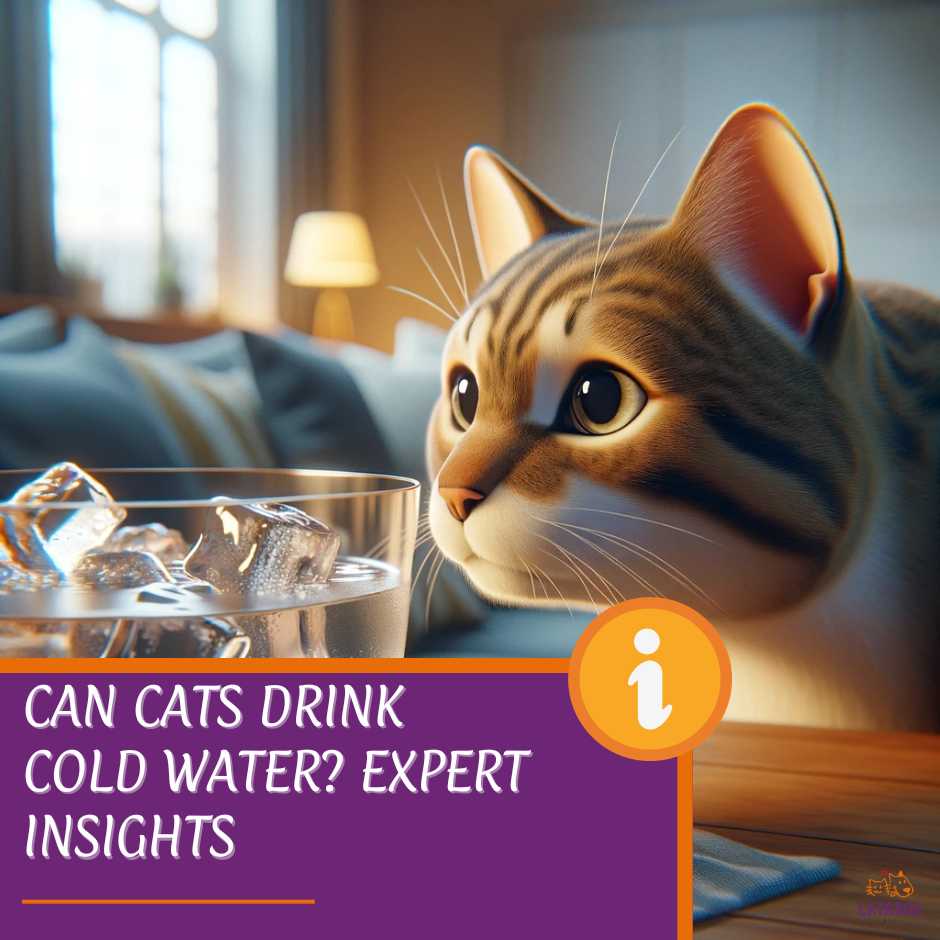Water is crucial for the health and well-being of your beloved feline friends, much like it is for us humans.
You might be aware of the basic needs of your cat, but have you ever paused to wonder about their preference for water temperature?
So, can cats drink cold water?
It’s essential to know that while many cats seem indifferent to their water’s temperature, some do exhibit a preference for cooler water.
This can stem from a cat’s instinctual desire for fresh and running water, as it would be found in a natural environment. (1)
However, it’s important to note that cats generally prefer cool to cold water over stagnant, warm water. This preference for cool water is due to their instinctual preference for fresh and running water.
To ensure your cat stays hydrated, it’s best to provide them with clean water and the best ways to cool water rather than warm water. Image credit: rihaij, Pixabay.
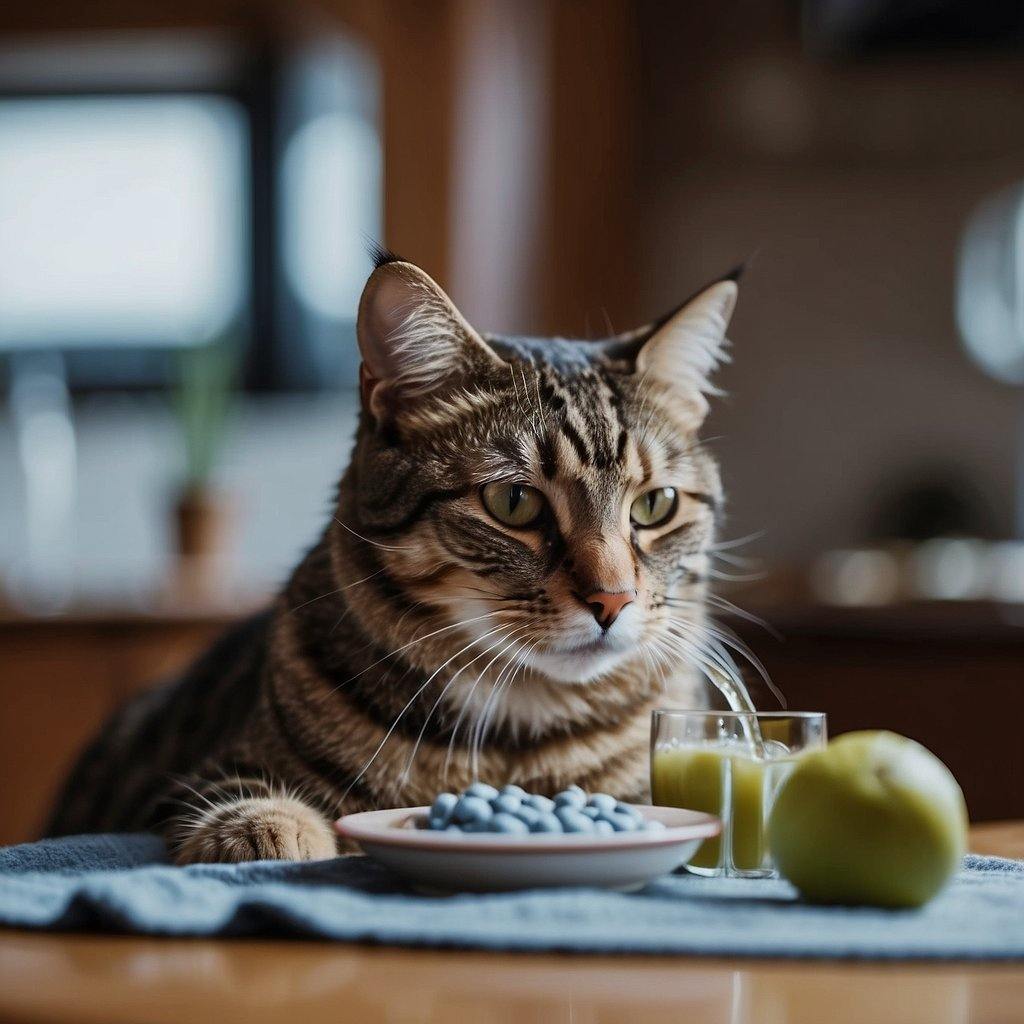
Just like we’re advised to drink a certain amount of water each day, cats also have daily hydration needs—generally around 60 ml per kg of their body weight or about 1-2 cups of water. (2)
It’s important not only for their hydration but also for their overall health. A properly hydrated cat is a happy and healthy cat.
I once knew a cat who exhibited significant health improvements after her owner became vigilant about her daily water intake. Staying well-hydrated helped her maintain kidney health and a shiny coat!
Cats should drink around 3.5-4.5 ounces of water per 5 pounds of body weight per day, meaning a 10-pound cat should drink around 7-9 ounces or about 1-2 cups of water and wet food with high water content daily.
Key Takeaways
- Cats often prefer cool water, which mimics the freshness of natural water sources.
- They should typically consume around 60 ml of water per kg of body weight daily.
- Adequate hydration can lead to noticeable improvements in a cat’s health.
Can Cats Drink Cold Water?
Have you ever caught your furry friend pawing at a droplet on a chilly water glass? It begs the question: can your cat sip on something cold, or is it a no-go? Let’s clear the air with a dose of cold, hard facts!
Hydration Hype:
- Cats + Water = Essential combo. To keep cat staying hydrated is non-negotiable for kitty health, warding off kidney and urinary tract woes.
- Temperature Temptations: Cats often equate cold with freshness—think pristine mountain streams (or that dripping faucet they’re obsessed with). (3)
Scientific Scoop: A study from the Journal of Feline Medicine and Surgery didn’t exactly put a thermometer in our feline friends’ water bowls, but the overall hydration subject is well-researched. (4)
Turns out, making water more appealing, temperature-wise, can boost your cat’s interest in staying hydrated.
So, Can Cats Drink Cold Water?
- Yes, they can. No studies show chilling dangers.
- Benefits? Absolutely. Think “purr”sonal preference; many felines fancy it frosty.
- Caveats? Avoid extremes. Not too cold – we don’t want the kitty’s brain to freeze!
Here’s the Deal:
- Offer variety: Room temp or cold, let your cat be the critic.
- Observe: Do they drink more when it’s cool? Take note.
In short, there are no ‘paws’ for alarm offering your cat cold water—it could even keep them more consistently hydrated.
Remember, water is their wellness elixir, so tuning into their temperature tastes could contribute to their happy, healthy nine lives!
The Role of Ice Water in Cat Hydration
Did you know? A simple ice cube might be the unsung hero in your cat’s water bowl! Let’s chat about what ice water could do for your furry friend’s hydration.
Hydration Station! When the mercury rises, you might crave a frosty drink, and guess what? Some cats do too!
Ice water can be a cool treat for your kitty, potentially encouraging them to drink more and stay hydrated. Think of it as their little kitty cocktail!
- Pros:
- Keeping Cool: On a hot day, ice water can help lower your cat’s body temperature.
- More Water, Please: The novelty of ice might pique their curiosity, leading to increased water intake.
- Cons:
- Watch the Teeth! Overeager cats might try biting into ice, which can be hard on their teeth.
- Brrr, That’s Chilly! Water that’s too cold may cause stomach discomfort for some cats.
A Spoonful of Fun Heard the tale of the kitty that found a frozen treat in their water. Freezing catnip or a favorite treat in ice cubes can turn hydration into a game!
Plus, as the ice melts, it’s a story with a tasty ending.
| Creative Hydration Tips |
| Freeze treats in ice cubes |
| Offer ice cubes as a plaything |
| Use shallow water with ice |
Remember, while these tricks may intrigue many feline friends, they’re as unique as you and me. Some prefer their water sans ice — just plain and simple.
So next time you’re filling up that water dish, why not drop in an ice cube from the freezer and observe? Your cat’s next sip of cat’s water might just be a cooler adventure with hepper water.
Keep a watchful eye though; what works for one whiskered critter might not be another’s cup of tea… or should I say, a bowl of hepper cat’s water from the freezer to prevent whisker fatigue!
Risks and Precautions with Ice Water
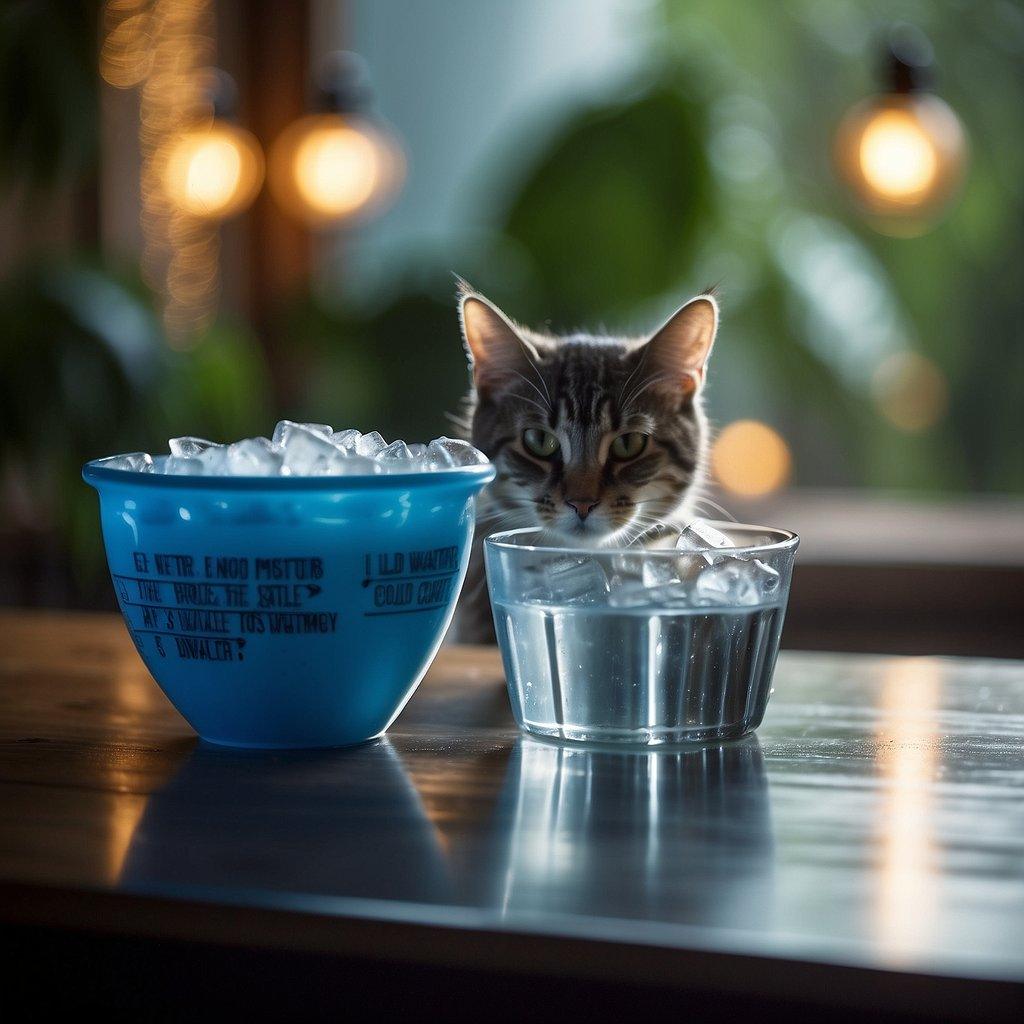
Have you ever wondered if that chilly ice water could give your cat more than a brain freeze? (5)
While it’s generally safe for your cat to sip on ice water, there are a few things you should keep in mind to ensure their well-being.
Potential Risks:
- Gastrointestinal Upset: Sudden changes in water temperature could potentially lead to a tummy ache. Just like people, cats may experience discomfort or gastrointestinal upset if they consume very cold water too quickly.
- Teeth Sensitivity: Ever bitten into an ice cream and recoiled at the sudden teeth sensitivity? Cats can have dental issues too, and ice water might be uncomfortable for those with sensitive teeth.
Veterinarian Insights:
Veterinarians suggest moderation when it comes to ice water. If your cat enjoys it, it’s great during those sweltering summer days but keep an eye out for any signs of discomfort.
Alternative Hydration Solutions:
- Cat Water Fountains: These are a fantastic way to encourage your cat to drink more water while avoiding the extreme temperatures of ice water. Cats are often fascinated by running water, which can inspire them to stay hydrated.
Interested in a DIY project? Here’s a simple guide:
- Get a small, quiet submersible pump.
- Place it in a shallow, wide bowl.
- Add a filter if possible, to keep the water clean.
- Ensure the water flow is gentle; it shouldn’t splash or scare your kitty.
Remember, safety first: Always monitor your cat when introducing new elements to their drinking habits. Keep that water fresh and comfortable, and your furry friend will thank you!
Expert Insights and Advice
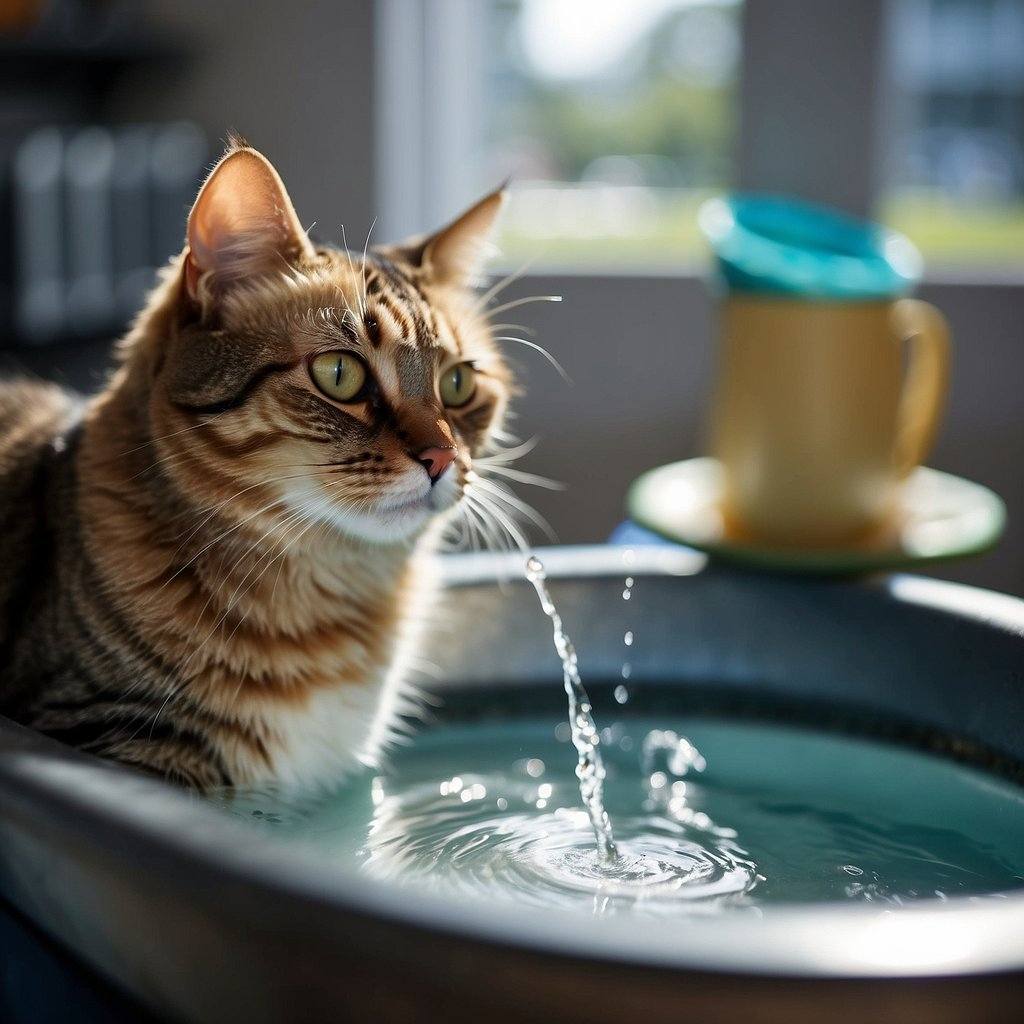
Have you ever watched your cat linger around the fridge, hoping for a cool treat? You might wonder, can your furry friend safely sip on cold water? Let’s see what the experts have to say!
Veterinarian Recommendations
- Dr. Whiskerson: “Room temperature water is typically what’s recommended for cats. However, a splash of cold water on a hot day can help keep your kitty cool!”
- Dr. Claw: “If your cat enjoys cold water and it helps them stay hydrated, it’s generally fine in moderation.”
Hydration and Health
Staying properly hydrated is essential for preventing health issues in cats, such as urinary tract and kidney diseases. (6)
A 2023 case study noted that cats with increased water intake had fewer episodes of urinary tract infections and bladder issues.
Who knew that encouraging your cat to drink more water, including through canned food and adding more wet food to your cat’s diet, could have such positive effects on their bladder health?
Cats that eat only dry food, or who have a combination diet, need to drink more to meet their bodily needs for hydration.
| Case Study | Health Outcome | Details |
| Kitty #1 | Lower urinary issues | Increased water intake |
| Kitty #2 | Improved kidney function | Frequent hydration checks |
A splash of variety can entice your cat to drink more – adding ice cubes might just tickle their whiskers the right way! Remember, every cat is unique and their preferences can vary.
Practical Tips:
- Observe Your Cat: Some may prefer a chilly sip, while others stick to room temp.
- Freshness Matters: Change the water often to keep it clean and appealing.
- Ice Cubes: They can be a fun way to encourage hydration – watch them play paw hockey with the ice!
Have you got a finicky feline? Perhaps a flowing water fountain might entertain their taste and up their water game.
Remember, if you’re ever unsure, a quick call to your vet can clear up any hydration hesitations. Stay cool, cat companions!
Comparing Water Temperatures
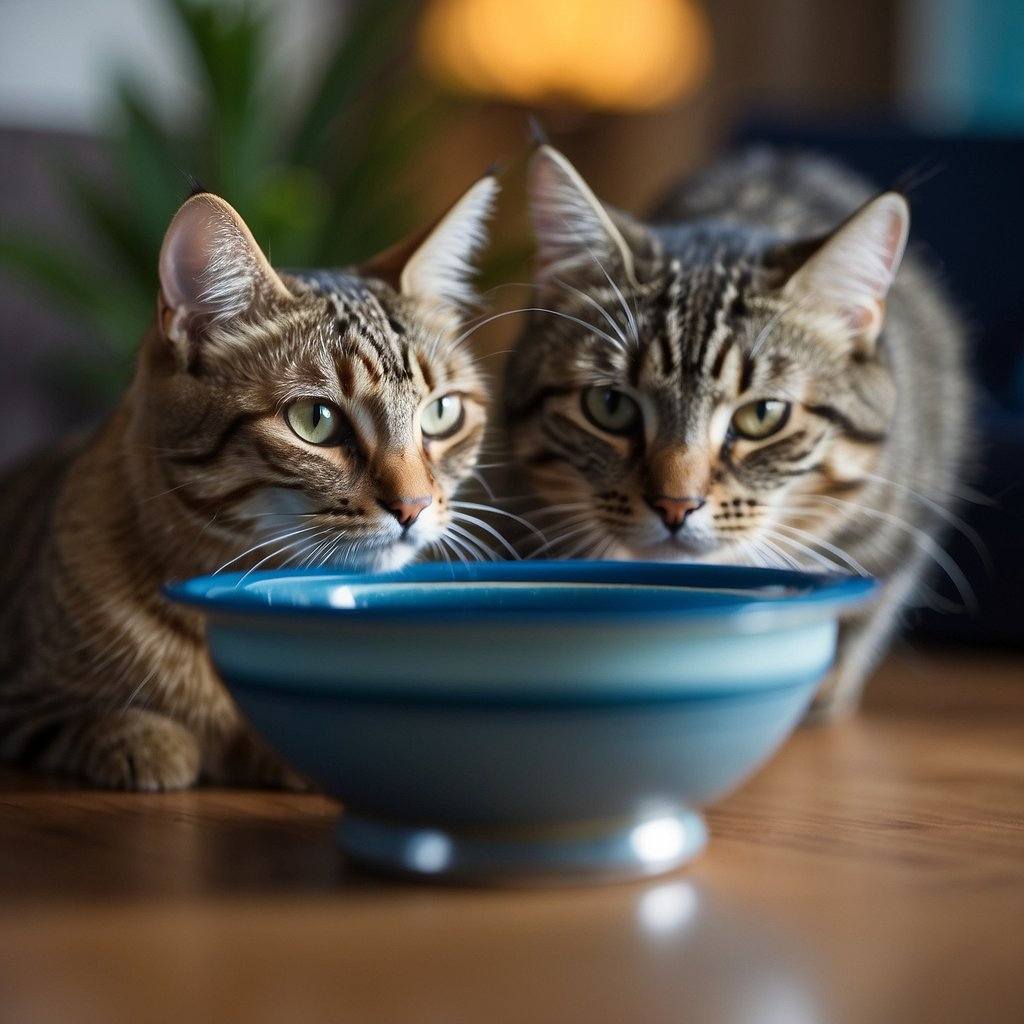
Ever wondered if your feline friend has a preference when it comes to the temperature of their water? Just like us, cats have opinions on what they sip!
It turns out the water’s temperature can make a real difference in how cats perceive and enjoy their hydration.
Interestingly, a study has shown that cats are like little Goldilocks when it comes to water temperature. They often prefer it just right—not too hot, not too cold.
Cats typically favor water that is around room temperature. Why? It’s thought that this preference relates to their instincts. In the wild, room-temperature water is a sign of fresh, safe water.
It’s important to place the water in a location that is not close to the food bowl. It’s thought that cats in the wild do their hunting away from their water source, so it might help replicate this.
However, you can try experimenting: Place the water next to their food bowl and see if it makes a difference for domestic cats.
But hey, cats are individuals! For instance, the fluffy Siberian cat might be less sensitive to a cooler drink, while a sleek Sphynx could appreciate a slightly warmer bowl to match its need for warmth.
Do you know if your cat has a preferred water climate? It’s not something every owner knows.
A surprising survey result indicated that many cat owners aren’t sure about their pets’ hydration preferences, including their water consumption.
We need to bridge this gap!
By noting if your kitty tends to avoid drinking after you refill their bowl with cold tap water or from the bathtub, after a bath, you might pick up on their preferences for ceramic cat drink bowls.
To help illustrate this:
- Normal body temperature for cats: 100.5-102.5°F
- Recommended water temperature: Room temperature (around 70°F)
Did You Know?
- Some cats might steer clear of cold water if they have sensitive teeth.
- Others may be drawn to the cooling effect on a hot day.
So, grab a thermometer next time and play detective with your cat’s water bowl!
Keeping your furry friend hydrated is important, and knowing their water temperature preference is just one piece of the puzzle. Cheers to happy, hydrated kitties!
Quick Recap
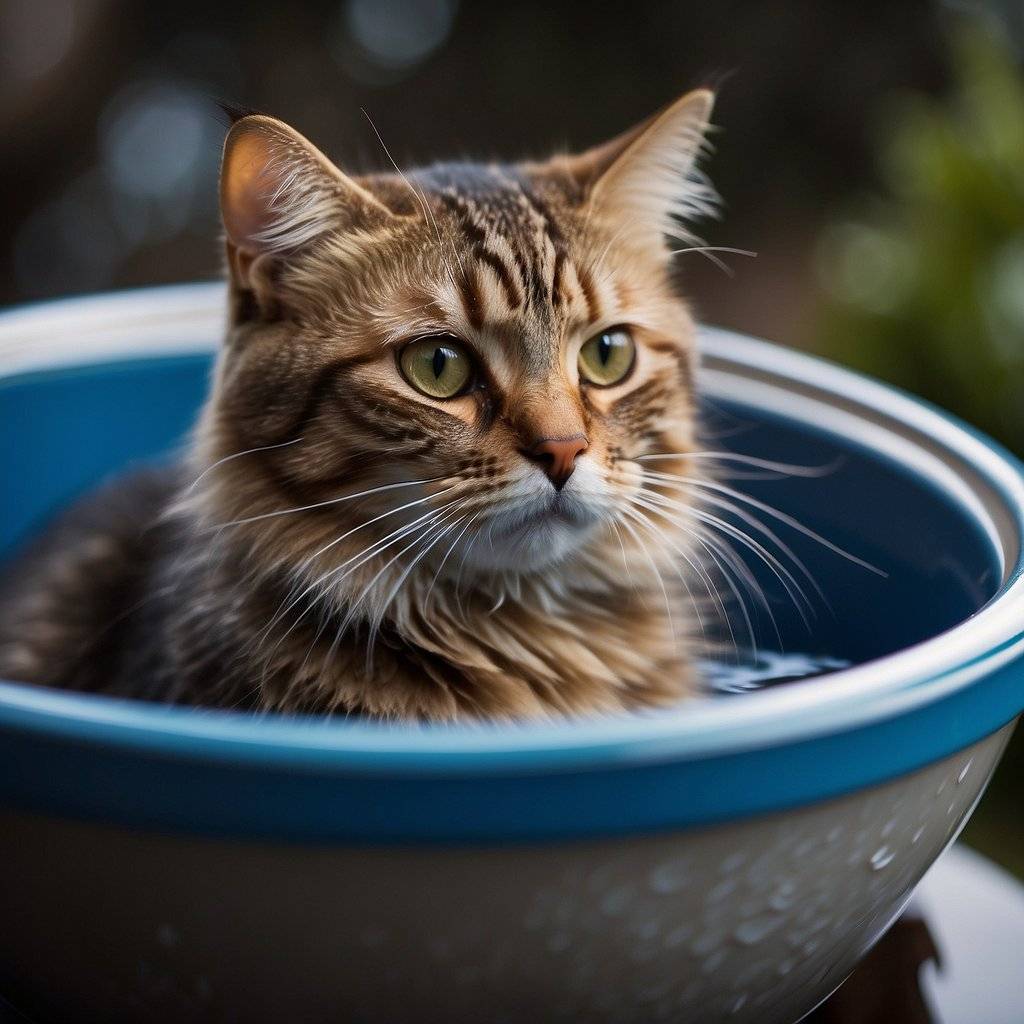
Are you a cat owner pondering if it’s okay for your fuzzy friend to sip on some chilly water? Well, the consensus from various sources is in—and it’s a bit mixed.
First off, it’s important to understand that your cat’s body temperature usually hovers between 100.5-102.5°F (38-39.2°C).
What does that mean for their hydration habits? Here’s a quick rundown:
- Room-temperature water is usually the best bet. It’s closest to your cat’s natural body temperature, making it easy for them to handle.
- Cats can drink cold water, and some may find it refreshing, especially on a hot day.
Remember, your cat’s preference may vary, and while cold water is generally safe, consider these points:
- Extra chilly beverages, like those with ice cubes, might be too intense and cause discomfort, similar to the human “brain freeze.”
- To avoid any potential shock to their system, introduce colder options gradually.
Wondering about your cat’s hydration needs? Just like you, they need consistent access to fresh water. Ensuring this will help prevent dehydration and keep your kitty happy and healthy.
If you’re looking for a way to keep your cat hydrated with a little twist, try these tips:
- Offer a mix of water temperatures and see which one your cat prefers.
- If you opt for cold, monitor your cat to ensure they’re comfortable and enjoying their drink.
- Always refill the water bowl with fresh water daily—temperature aside, cleanliness is key!
In summary, moderation and observation are your best pals when it comes to introducing anything new to your cat’s diet, including cold water.
Stay attuned to your cat’s reactions, and you’ll be sure to keep them both hydrated and happy!
Frequently Asked Questions
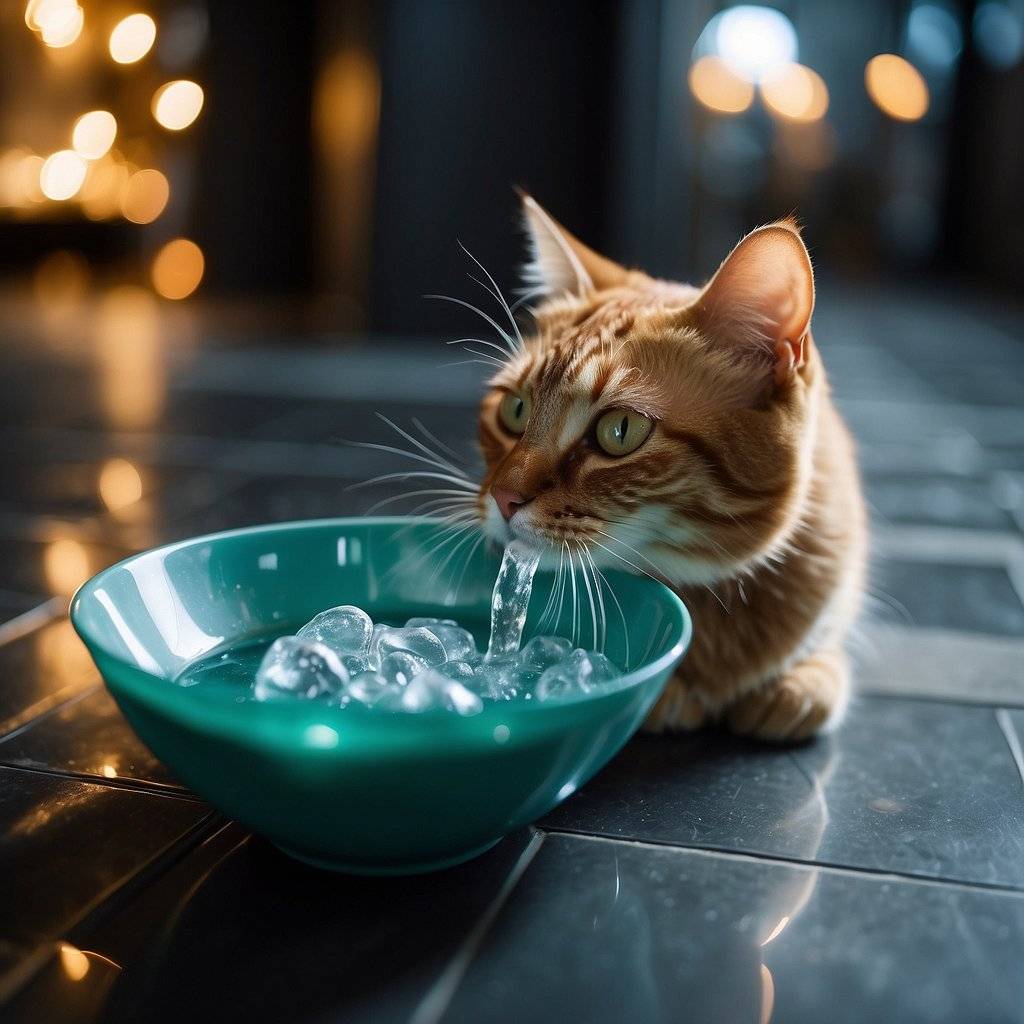
When it comes to your cat’s hydration, you might wonder if it’s cool to offer cold water. Let’s clear up some common curiosities you may have about your furry friend’s drinking habits.
Is it safe for my feline friend to sip on chilly H2O?
Absolutely! Your whiskered companion can drink cold water. In most cases, it’s completely safe.
Just watch out for overly cold temperatures that might not be to every cat’s taste.
Do our purring pals have a preference for water temperature?
Cats can be finicky, and although some might not fuss over water temperature, others might prefer it to match their body warmth, which sits cozily between 100.5 and 102.5°F.
How does weather—particularly the hot kind—affect a kitty’s hydration choices?
When the sun is beating down, your cat might lean towards a cooler sip to refresh themselves.
Just remember, room temperature is often best to avoid any chilly surprises.
Are There Specific Conditions Under Which Cats Should Avoid Cold Water?
Generally, cold water is fine, but if your cat is under the weather or it’s particularly frosty outside, sticking to room-temperature water could be more comfortable for them.
What’s the verdict on giving kitties a splash of cold milk—is it a no-go?
Stick to water! Many cats are lactose intolerant, and cold milk could cause digestive upset. Water is the best beverage for keeping cats healthy and hydrated.
How Can I Safely Introduce Ice Water to My Cat?
Start slow! Mix a few ice cubes with room-temperature water. This way, your cat can explore and decide if they’re fans of the chilled version without a shock.
Is Cold Water Harmful to Cats?
Not usually. Cold water isn’t harmful to most cats. However, observe your pet’s reaction and preferences, as each cat has a unique taste.

